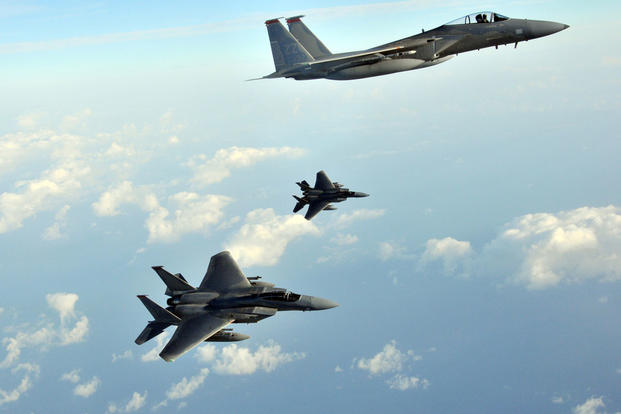WASHINGTON -- The Air Force responded to the National Commission on the Structure of the Air Force’s recommendations in a report to Congress March 4.
Of the Commission’s 42 recommendations, Air Force officials disagreed with only one and are already in the process of implementing 25, as well as developing plans or pilot programs for another 16.
“The body of work that came out of the commission will help us advance the ball toward an even stronger total force,” said Secretary of the Air Force Deborah Lee James, “and I’m convinced the future of the Air Force includes a greater reliance on our Guard and Reserve components.”
The disestablishment of the Headquarters Air Force Reserve Command was the only recommendation in which the Air Force disagreed with the commission. Elimination of the AFRC would not result in substantial savings, as nine different major commands would have to assume the roles and responsibilities currently accomplished by the Headquarters AFRC. Additionally, the current structure allows the Chief of the Air Force Reserve to manage authorized and appropriated Reserve resources as required by key statutory obligations.
Over the last two years, the Air Force has made significant progress toward improving collaboration and cooperation between the components to strengthen and institutionalize relationships across the total force. All three components have participated in the Air Force’s budgetary discussions and planning from start to finish beginning with the fiscal year 2015 President’s Budget. This process enables an integrated approach to maximize capability and capacity in times of increasing fiscal constraints.
Transformation during wartime is difficult and the Air Force is short of warfighting capacity in nearly all mission areas.
Even though the NCSAF report identified possible cost savings associated with moving approximately 36,000 active Airmen into the reserve component and related savings of roughly $2 billion, Air Force analysis does not support this concept.
Based on secretary of defense-mandated dwell rates, the Air Force has capacity shortfalls across almost all mission areas, assuming approximately a 12% risk to meeting deployment demand and other requirements; shifting the 36,000 to the reserve component would exacerbate this risk to nearly 20%. To effectively meet requirements and maintain the active component’s 1-to-2 and reserve component’s 1-to-5 dwell times , the Air Force needs to grow both the active component and the reserve component.
“No one is more invested in total force integration than the Air Force,” said Lt. Gen. James F. Jackson, the Chief of Air Force Reserve. “Going forward, there is no doubt that our Air Force is going to rely more, not less, on our Reserve and National Guard forces. It is essential to leverage our reserve components more effectively in the current global security environment.”
The Air Force has spent the last year thoroughly analyzing 80 percent of the Air Force mission-sets and taking a close look at our active component and reserve component balance. Over the course of the next year, the Air Force will continue evaluating the remaining 20 percent of the mission areas, as well as re-look at major mission areas that need further examination.
The overall assessment so far resulted in changes to the Air Force’s fiscal 2016 budget. Nearly 3,000 positions were added to the reserve component’s end strength. The Air Force bought back F-15C Eagles for ANG units and actively associated them; re-established a classic association with the RQ-4 Global Hawk; made some adjustments in the space positioning, navigation and timing system; and grew reserve component in the cyber mission area.
“The evolution of our total force over the years is a great success story, but much of that story has yet to be written,” said General Mark A. Welsh, III, the chief of staff of the Air Force. “We need to be as good at the headquarters level as our Airmen are at the operational and tactical levels. Those Airmen, who’ve been fighting side-by-side for years, don’t see the difference between an active component member, guardsman or a reservist. And those who benefit from American airpower really don’t care. They just know that without it … you lose.”
The NCSAF was established by Congress in 2013 to determine how the Air Force’s structure should be modified to best fill current and future mission requirements, and the commission first presented their findings on Capitol Hill in January 2014. During the same period, the Air Force initiated a comprehensive review of the Air Force total-force enterprise.
Upon completion of the Air Force’s internal review and the commission’s report, the Air Force established the Total-Force Continuum, or TF-C, an organization led by a brigadier general from each component. The TF-C is charged with pursuing legislative, policy, educational, operational and organizational changes to more fully integrate the three components into “One Air Force” and identifying the optimal balance of Active, Guard and Reserve across all mission sets. Subsequent recommendations continuing the Air Force’s efforts at integrating across the components will be presented in future budget proposals.
“One unified Air Force needs to be the way we do business without even thinking about it,” said Lt. Gen. Stanley E. Clarke, III, the director of the Air National Guard. “We are committed to ensuring we evolve in our total-force integration with a synchronized team always ready to deliver unparalleled airpower anywhere in the world.”























